 |
| |
CHO-(GO-CHU)-JANG
Sweet & Spicy Red Chili Pepper Sauce 초(고추)장 | ||
Cho (gochu) jang (or chojang for short) is a unique spicy-sweet red chili pepper sauce. It gives off a sweet, spicy flavor and goes well with all kinds of mixed rice dishes such asbibimbop and hweh dupbop or even noodle dishes such as jangban guksu. It can also be used as a vegetable dipping sauce or a spicy salad dressing. Alternatively, when eating hweh(sashimi), chojang can be used as a dipping sauce as opposed to the standard soy sauce mixed with wasabi.
It’s a very simple sauce to make using few ingredients such as gochujang, vinegar, and sugar. Other optional ingredients can include sesame oil, minced garlic and even finely chopped green onions. Depending on the brand of gochujang, more or less vinegar and sugar may be used, depending on the preference in the level of thickness as well as spiciness. Chojang can also be purchased in squeezable bottles much like ketchup at your local Korean supermarkets.
|
| RECIPE INGREDIENTS |
|
| COOKING DIRECTIONS |
|
| FEATURED ITEMS: CLICK & SHOP |
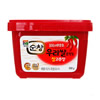 |
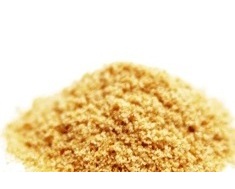 |
| |
DA-SHI-DA
Soup Stock 다시다 | ||
Dashida is a Korean soup stock which can consist of beef, clam or anchovy flavored seasoning for making soups or casseroles. Some types can also contain vegetable mix to enhance flavors and you won’t need more than a spoonful of dashida to bring out the rich flavors of your stews, soups and casseroles. It's an ideal base for all kinds of soups, including beef, dumpling, and even spicy soups which are essential for achieving the perfect flavor of delicious Korean food.
|
| FEATURED ITEMS: CLICK & SHOP |
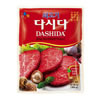 | 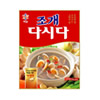 | 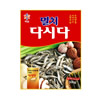 |
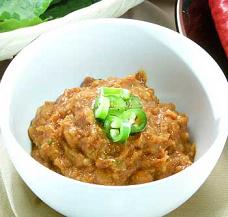 |
| |
DWEN-JANG
Soybean Paste 된장 | ||
Dwenjang is a traditional bean paste that is fermented from soybeans which has been a fixture of the Korean diet for centuries. Dwenjang can be also used to make stews such as a dwenjang chigae, or as a component in miso like soups. It is widely included in ssangchu (red lettuce leaf) while eating Korean meat dishes such as galbi, bulgogi, or samgyupsal. To see visual illustrations, click here.
It is similar in texture and consistency to Greek hummus and it can be eaten in raw paste form by using it as a dip when eating vegetables, similar to the way Westerners dip celery sticks into peanut butter.
Dwenjang is high in flavonoids and other beneficial vitamins, minerals, and hormones which are thought to be anti-carcinogens and also known to contain high quality proteins in the form of amino acid which can aide with digestion.
|
| FEATURED ITEMS: CLICK & SHOP |
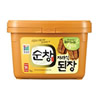 | 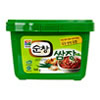 |  |
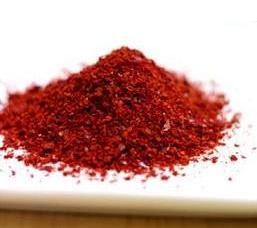 |
| |
GO-CHU-GA-RU
Red Chili Pepper Powder 고추가루 | ||
Gochugaru is red chili peppers that are dried and then grounded into a coarse or fine powder.Gochu literally means chili pepper and garu means powder in Korean. It is used extensively in Korean cooking to add spiciness & flavors and is one of the most popular ingredient found in numerous dishes. Some dishes that contains abundant amount of gochugaru are tukbokki,koatgaetang, dakdoritang, kimchi chigae, kimchi, kkakdugi, and nakji bokum just to name a few.
The quality of gochugaru depends on how well chili peppers are riped and dried in natural sunlight or with heat. Naturally drying chili peppers under sunlight is considered best, resulting in vibrant red colored chili peppers that transforms into spicier taste. Also, the purer the chili powder, the spicier it is and with a proper amount, it will make any dishes savory and can arouse more appetite.
Nowadays, most Koreans buy packaged gochugaru instead of making their own as it can take great amount of time and care to produce from scratch. As it is important in any type of cooking, it's essential to shop for basic ingredients that are premium in quality, but yet reasonably priced which can make the difference in its overall taste.
|
| FEATURED ITEMS: SHOP ONLINE |
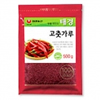 |
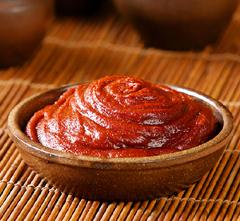 |
| |
GO-CHU-JANG
Korean Chili Pepper Paste 고추장 | ||
Gochujang is a popular Korean condiment made from glutinous rice powder mixed with both powdered, fermented soybeans and red peppers. It is used in various Korean stews & soups and also used to marinade meat. It can also be eaten as a dip when eating vegetables, similar to the way dwenjang is used as a dipping sauce. It is widely included in ssam (vegetable leaf wrap) while eating hweh as well as to wrap galbi, bulgogi, or samgyupsal. To see visual illustrations, click here. Gochujang is thick in composition and consuming this chili pepper paste alone can get quite hot & spicy in taste.
Gochujang is usually purchased in jars already prepared at Asian supermarkets and is an essential staple of the Korean kitchen. By adding a few more ingredients to the already prepared paste, a more tasty sauce called ssamjang can be served as a dip or dressing.
|
| FEATURED ITEMS: CLICK & SHOP |
 |  |  |
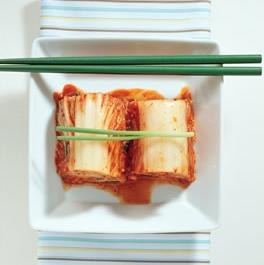 |
| |
KIM-CHI
Fermented Cabbage 김치 | ||
Kimchi is a national Korean dish consisting of fermented chili peppers and vegetables, usually based on cabbage. It is suspected that the name kimchi originated from shimchae (salting of vegetable) which went through some phonetic changes: shimchae > dimchae > kimchae >kimchi.
Common ingredients include Chinese cabbage, radish, garlic, red pepper, spring onion, ginger, salt, and sugar. While kimchi is generally identified internationally as Chinese cabbage fermented with a mixture of red pepper, garlic, ginger, and salted fish sauce, several types of kimchi exists, including regional and seasonal variations. There are variants, includingkkakdugi, based on radish and containing no cabbage.
Kimchi has been cited by Health Magazine as one of the world's five "healthiest foods", with the claim that it is rich in vitamins, aids digestion, and may even prevent cancer. The health properties of kimchi are due to a variety of factors. It is usually made with cabbage, onions, and garlic, all of which have well-known health benefits. It also has active and beneficial bacterial cultures, like yogurt. Lastly, kimchi contains liberal quantities of red chili peppers (gochugaru) which has been suggested to have health benefits as well.
The best tasting kimchi is stored in room temperature for an average of six months to reach its full flavor. It is a popular side dish but is also often used as an ingredient in cooking other popular Korean dish, including kimchi chigae (kimchi soup) and kimchi bokumbop (kimchi fried rice).
Fun fact: Like the McDonald’s University of Hamburgers in Illinois, US, there is a Kimchi Research Institute located in Pusan National University, South Korea.
|
| RECIPE INGREDIENTS |
|
| COOKING DIRECTIONS |
|
| FEATURED ITEMS: CLICK & SHOP |
 |
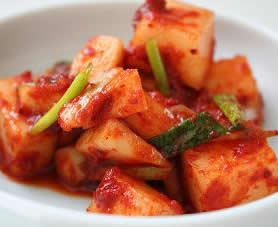 |
| |
KKAK-DU-GI
Diced Radish Kimchi 깍두기 | ||
Kkakdugi is a type of kimchi which has all the ingredients of the popular staple, but instead of using Chinese cabbages, it’s substituted with daikon radishes. Radishes are cut into small cubes and flavored with salt, red chili pepper powder (gochugaru), spring onions, and ginger. After mixing all ingredients, it is traditionally stored away in a cool/dry place for approximately two weeks for fermentation. There are many different variety of this side dish that are enjoyed by Koreans at home or which can be found at popular restaurants. Other variations exist using different types of daikon and/or distinctive ingredients such as tiny salted shrimp, water dropwort leaves, raw oysters, and assortment of spices. Kkakdugi is served cold and usually consumed when the fermented radish is crisp as opposed to being soft.
Kkakdugi along with other types of kimchi is a popular staple/side dish and most popular while eating sollontang, galbitang, or samgyetang. Additionally, it is known to share many of the health benefits of kimchi which can also aid in digestion of food.
|
| RECIPE INGREDIENTS |
|
| COOKING DIRECTIONS |
|
| FEATURED ITEMS: CLICK & SHOP |
 |
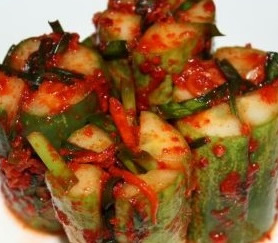 |
| |
O-I-SO-BA-GI
Stuffed Cucumber Kimchi 오이소박이 | ||
Oisobagi is another type of kimchi that is loved by Koreans, especially during the hot summers. It’s also known as stuffed cucumber kimchi where cucumbers are specially prepared and formed into a pocket then stuffed with vegetables and spicy kimchi paste. It is usually served alongside a meal as a side dish and considered to be very healthy and delicious, supplementing a well-balanced, low-calorie meal.
Keep in mind that kimchi can be made with cabbage, radishes and many other vegetables including cucumber and it always includes red chilies. It is the national dish of Korea, where no meal is served without at least one variation of this spicy, condiment-like salad. If you enjoy the taste of kimchi, you’ll be sure to like oisobagi as well. |
| RECIPE INGREDIENTS |
|
| COOKING DIRECTIONS |
|
| FEATURED ITEMS: CLICK & SHOP |
 |
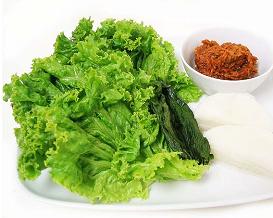 |
| |
SSAM
Vegetable Leaf Wrap 쌈 | ||
Ssam refers to various leaf vegetables which are used to wrap a piece of bite-size meat, along with dwenjang, gochujang or ssamjang paste and some rice into a bundle. The vegetables used for wrapping can vary but it primarily consists of fresh red leaf lettuce, sesame leaves, or parboiled cabbage leaves. Other side dishes (banchans) can also accomodate the meat depending on the eater's preference and also what is available on the table. Usually, freshly sliced hot peppers as well as garlic bits are added for its bold flavors and tastes.
With its combination of rice, meat, vegetables and various soybean pastes, the wrap offers a balanced intake of necessary nutrients without the greasy aftertaste that is left by many forms of meat.
|
| VISUAL ILLUSTRATIONS |
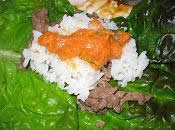 | 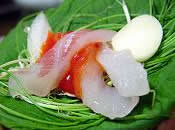 |
| FEATURED ITEMS: CLICK & SHOP |
 |  |  |
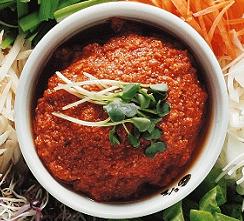 |
| |
SSAM-JANG
Mixed Soybean & Chili Pepper Paste 쌈장 | ||
Ssamjang is a mixed paste of gochujang (red chili pepper paste), dwenjang (fermented soybean paste) and other seasonings. It is frequently used as a condiment for wrapping a cooked meat and steamed rice within vegetable leaves such as lettuces, cabbages and sesame leaves. To see visual illustrations, click here. It is also widely used as a dip for fresh pepper, cucumber and carrot, and it can be applied as a salad dressing. Ssamgjang can be homemade or purchased at Korean supermarkets in readily available jars.
|
| RECIPE INGREDIENTS |
|
| COOKING DIRECTIONS |
|
| RECIPE INGREDIENTS: BEEF STIRRED VERSION |
|
| COOKING DIRECTIONS: BEEF STIRRED VERSION |
|
| FEATURED ITEMS: CLICK & SHOP |
 |  |  |
No comments:
Post a Comment